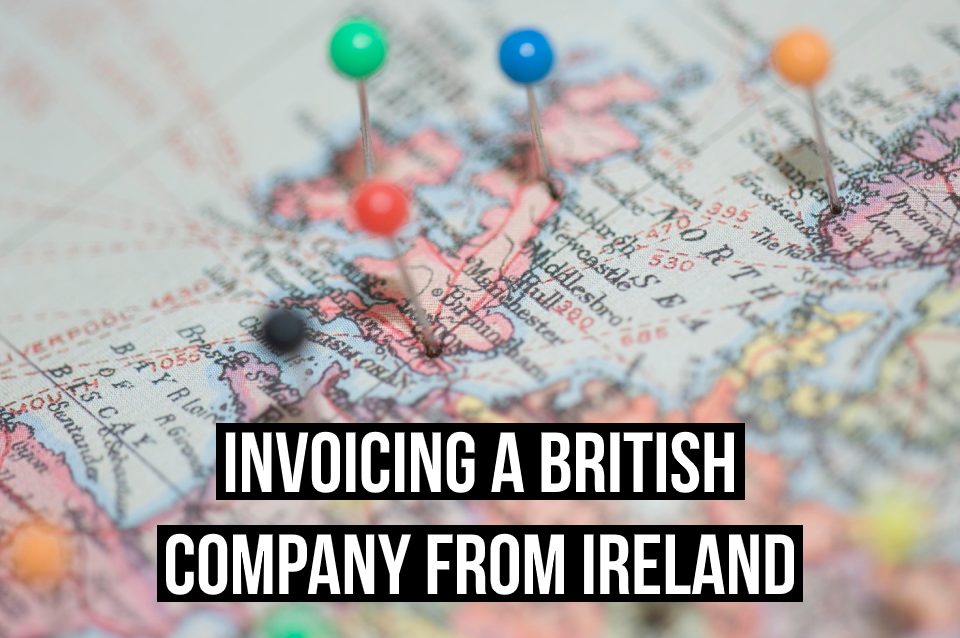The UK is one of Ireland’s main trading partners, purchasing billions of euros of goods and services from Irish businesses every year. And if you’re one of the many Irish freelancers or business owners that sells to companies in the UK, it’s important that you know to send invoices that are professional, legal, and tax-compliant.
This blog post therefore takes a look at everything you need to know about invoicing a UK company from Ireland, including what to include on an invoice template, how to apply sales tax, and the easiest way to create an invoice for British businesses.

What should I include on an Irish invoice template?
Whether you’re invoicing a business in the UK, another company in Ireland, or a client further afield, there’s some basic information that you need to include on every invoice you issue. It’s therefore important that you use an invoice template for Irish businesses that includes:
- Details about the invoice (a unique invoice number, the date of issue, the date of supply, a due date)
- Details about your business (name, address, registration number)
- Details about your customer (name, address, contact details)
- Details about the goods or services provided (the quantity, a description, the price per unit, the total amount due before tax).
Should invoices sent to UK companies include VAT?
If you’re registered for VAT and make taxable sales, your invoices should also include the rates of VAT charged, the total amount of VAT due, and the total amount due after tax. However, the way you should handle VAT when selling to clients outside of Ireland depends on a number of factors, including:
- Whether the customer is a business or a consumer
- Whether the customer is based in an EU member state or in a third-party country
- Whether the sale is for goods or services.
When you make a sale to a VAT-registered business in the UK, that sale is considered to be a B2B intra-community transaction, as you sell to a business (not a private individual) and the UK is a member of the EU (at least for the time being).
In general, B2B intra-community sales of goods and services need to follow a process called reverse charge, whereby VAT is recorded by the buyer instead of the seller. When you invoice a VAT-registered company in the UK, you need to make sure that your invoices include your customer’s VAT number and a note stating that ‘reverse charge applies’. If you’re supplying goods, you will also need to state that the sale is an ‘intra-Community supply of goods’.
However, if you’re invoicing a UK company that isn’t registered for VAT, you need to treat the sale as a B2C transaction and apply VAT in the same way as you would if you were invoicing a private individual. This could mean either charging VAT at the rate set in your own country or registering for VAT and charging the rate in your customer’s country.
It’s also worth bearing in mind that there are always a few exceptions to these rules, so it’s worth contacting Revenue or consulting the EU’s website to confirm exactly how you should go about managing VAT when invoicing a UK company from Ireland.
Which currency should I use when invoicing a UK company from Ireland?
Whenever you send an invoice to a customer outside of Ireland, you have the option of invoicing in a different currency. If you’re selling goods or services to customers in the UK, you can therefore choose whether you want to invoice in euros or pounds.
There are advantages and disadvantages of invoicing in either currency. If you invoice in pounds, your British clients may find it easier to compare your prices with competitors in the UK, but there will be extra work on your behalf, such as calculating the price according to the most recent exchange rate and accounting for any possible exchange gains or losses. On the other hand, if you invoice in euros, you won't need to calculate exchange rates, but it might be confusing or time-consuming for your customers who are used to paying in pounds.
If you do decide to send invoices to to British companies in pounds, you should make sure that your invoice template also includes the price in euros.
How to send an invoice to a UK company with invoicing software
The easiest way of invoicing a UK company from Ireland is to use online invoicing software like Debitoor. With Debitoor, you can create and send invoices in less than a minute. All you need to do is fill in the pre-built invoice template, add your customer’s details, and click send.
If you enter a UK address, the VAT rates will be updated accordingly, allowing you to apply the reverse charge procedure. Plus, whenever you create an invoice with Debitoor, you can select which currency you’d like the invoice to be in. Simply choose the currency from our extensive drop-down list to see the latest exchange rate, and then update your prices and total accordingly.
